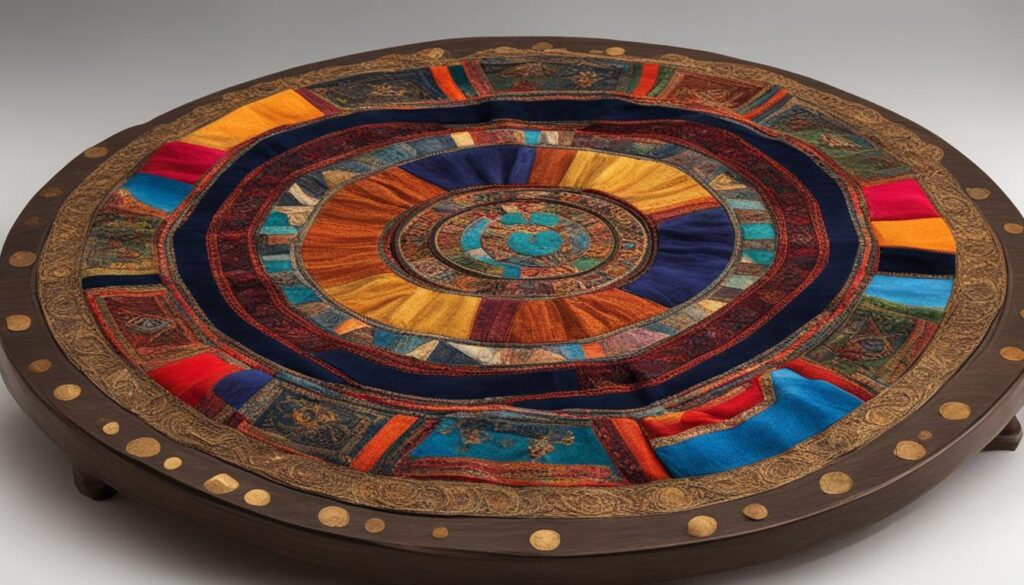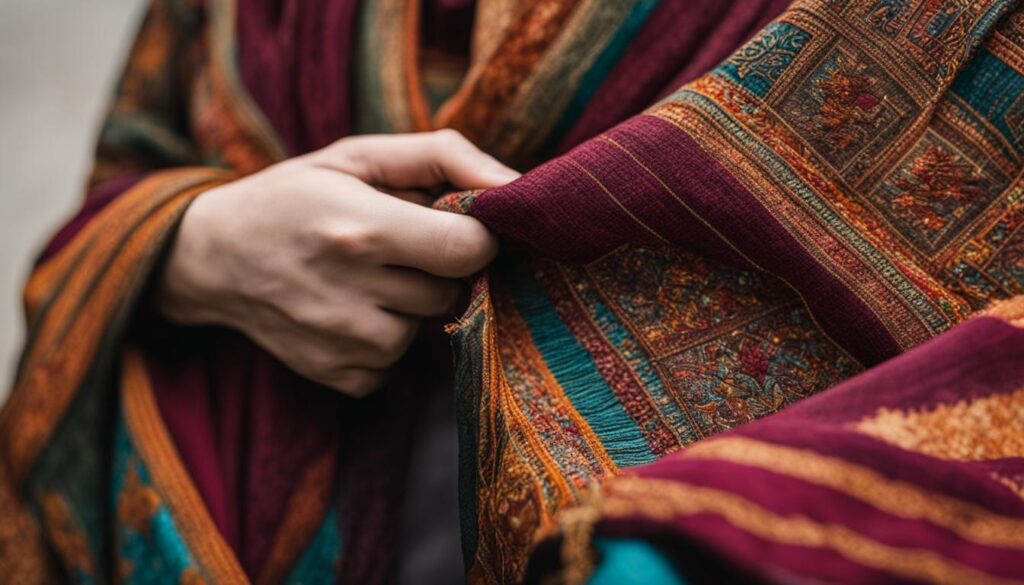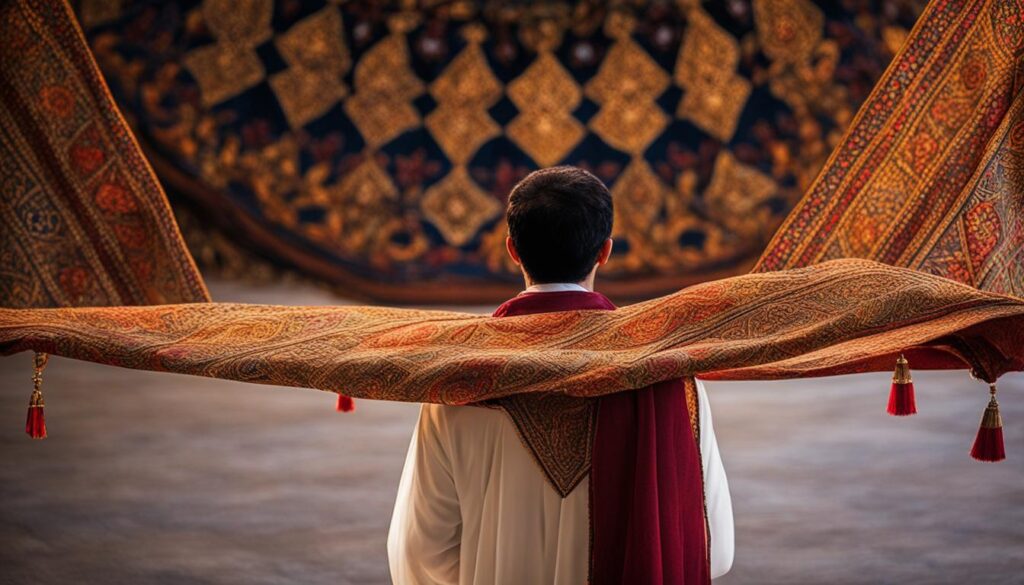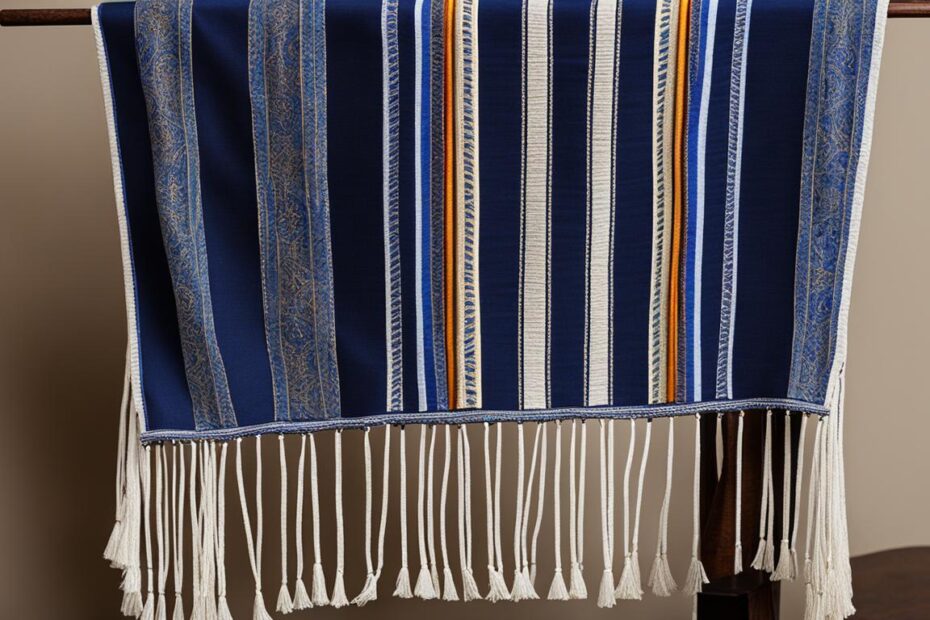The prayer shawl, also known as the tallit, holds deep spiritual significance for those who wear it. It serves as a reminder of the commandments of the Torah, with the fringes of the tallit symbolizing the 613 commandments. The numerical value of the word “tzitzit” (fringes) is 600, and with the addition of the threads and knots, it totals 613. This sacred garment also represents the oneness of God, with the winding of the threads around the knots corresponding to the numerical value of the Tetragrammaton and the word “ehad” (one). The tallit is a powerful symbol of reverence for God and plays a central role in Jewish worship.
Key Takeaways
- The prayer shawl, or tallit, symbolizes the commandments of the Torah and represents the oneness of God.
- It serves as a powerful reminder of reverence for God and plays a central role in Jewish worship.
- The fringes of the tallit symbolize the 613 commandments, with the winding of the threads around the knots corresponding to the numerical value of the Tetragrammaton and the word “ehad” (one).
- The tallit is made of various materials such as wool, cotton, and synthetic fibers, and its design has seen variations over time.
- There are also lesser-known prayer tools in Jewish customs, such as the kippah and tefillin, which hold their own unique significance.
The Origin and History of the Prayer Shawl
The prayer shawl, or tallit, has a rich history rooted in Jewish tradition. It is believed to have originated after Moses led the Hebrew people out of Egypt and received the commandments from God. The design of the tallit, with its fringes and knots, is reminiscent of the outer garments worn by Bedouins to protect themselves from the desert sun. Traditionally, the tallit was made of a mixture of silk and wool, symbolizing the connection to the sacrificial lamb. Over time, variations in color and materials used have emerged, but the essential design and purpose of the tallit remain the same.
The prayer shawl, or tallit, has a rich history rooted in Jewish tradition.
The history of the prayer shawl is deeply intertwined with Jewish customs and practices. It is considered a sacred garment that carries spiritual significance for those who wear it. The origin of the tallit can be traced back to biblical times, where it served as a symbol of devotion and obedience to God. As the Jewish people wandered through the desert, their garments protected them from the harsh elements, and the tallit became a symbol of God’s protection and guidance. Over the centuries, the tallit has evolved in its design and symbolism, yet it continues to play a central role in Jewish worship and spirituality.
The design of the tallit is rooted in ancient Jewish traditions and is steeped in symbolism. The fringes, or tzitzit, represent the 613 commandments of the Torah, with the numerical value of tzitzit being 600 and the addition of the threads and knots totaling 613. The act of wearing the tallit signifies a commitment to living a life in accordance with God’s commandments. Additionally, the winding of the threads around the knots corresponds to the numerical value of the Tetragrammaton, the four-letter name of God, and the Hebrew word “ehad,” meaning “one.” This symbolism emphasizes the oneness of God and the unity of His creation.
The prayer shawl, or tallit, represents a deep connection to Jewish history and spirituality
| Tallit Material | Early Design | Modern Design |
|---|---|---|
| Wool | Mixture of wool and silk | Variety of colors |
| Silk and Wool Blend | Traditional white with blue thread | Personalized embroidery and designs |
| Synthetic Fibers | Symbolic connection to sacrificial lamb | Durable and easy to care for |
In conclusion, the prayer shawl, or tallit, holds a significant place in Jewish history and tradition. Its origins can be traced back to biblical times and it remains a powerful symbol of devotion and connection to God. The design of the tallit, with its fringes and knots, carries deep spiritual meaning, representing the commandments and the oneness of God. Despite some variations in color and materials used, the essential purpose and symbolism of the tallit have remained consistent throughout the centuries, making it an integral part of Jewish worship and spirituality.
Variations in the Use of Prayer Shawls Among Different Sects
While the prayer shawl is a significant garment in Jewish worship, there are variations in its use among different sects. Traditionally, only Jewish men were required to wear the tallit, but today, many women also choose to wear it. In some Orthodox congregations, only married men wear the tallit. Additionally, the color of the tallit has traditionally been white with a blue thread, but variations in color have been accepted due to the difficulty of obtaining blue thread. These variations reflect the diversity in Jewish practices and beliefs.
Variations in Gender and Marital Status
Historically, the prayer shawl was primarily worn by Jewish men, as it is seen as a mitzvah (commandment) for them to fulfill. However, in more progressive Jewish communities, women have also started to wear prayer shawls as a way to actively participate in religious rituals. This inclusivity allows women to connect with their spirituality and express their devotion in a manner similar to their male counterparts.
Furthermore, some Orthodox sects have additional variations in the wearing of prayer shawls based on marital status. It is common for married men to wear the tallit during prayer services, while unmarried men may not be required to do so. This distinction reflects the traditional role of marriage and family within the Orthodox Jewish community.
Variations in Color and Design
Traditionally, the tallit was made with a white fabric and featured a blue thread, known as tekhelet, which represented the sky and the heavens. However, due to the historical difficulties in obtaining tekhelet, many prayer shawls today feature white threads with black or silver stripes instead. In some communities, prayer shawls may be embellished with additional colors or patterns to reflect personal preferences or family traditions.
While the core elements of the tallit, such as the fringes and knots, remain consistent, these variations in gender, marital status, color, and design demonstrate the diverse interpretations and practices within different Jewish sects. Despite these differences, the prayer shawl remains a symbol of devotion, unity, and reverence for God.
| Sect | Gender | Marital Status | Color | Design |
|---|---|---|---|---|
| Progressive | Both men and women | No distinction | Various colors | Personalized |
| Orthodox | Primarily men, some women | Married men | White with blue or other colors | Traditional or personalized |
| Conservative | Both men and women | No distinction | White with various stripe colors | Traditional or personalized |
The Materials Used in Crafting Prayer Shawls
When it comes to crafting prayer shawls, also known as tallits, a wide range of materials can be used. Each material provides unique qualities and characteristics that contribute to the overall look and feel of the prayer shawl. The choice of material is often influenced by personal preference, cultural practices, and availability.
Wool
Wool is a popular choice for traditional tallits. It is known for its softness, warmth, and natural insulating properties. Woolen prayer shawls are often highly valued for their comfort and ability to provide a sense of coziness during prayer. Additionally, wool has a rich history in Jewish tradition, as it symbolizes the connection to the sacrificial lamb.
Cotton
Cotton is another common material used in crafting prayer shawls. It is lightweight, breathable, and suitable for warmer climates. Cotton tallits are often favored for their softness and versatility. They offer a comfortable option for individuals who prefer a lighter fabric that allows for ease of movement during prayer.
Synthetic Fibers
Synthetic fibers, such as polyester or acrylic, are also utilized in the creation of prayer shawls. These materials offer durability, affordability, and easy care. Synthetic tallits are often appreciated for their ability to resist wrinkles and retain their shape over time. They are a practical choice for individuals seeking a low-maintenance option.
Ultimately, the choice of material for a prayer shawl is a personal decision, influenced by factors such as tradition, climate, and individual preferences. Whether it’s the warmth of wool, the lightweight feel of cotton, or the convenience of synthetic fibers, each material contributes to the overall significance and experience of wearing a prayer shawl.
| Material | Qualities | Common Use |
|---|---|---|
| Wool | Soft, warm, insulating | Traditional tallits |
| Cotton | Lightweight, breathable | Warmer climates |
| Synthetic Fibers | Durable, affordable, easy care | Low-maintenance option |
The Evolution of Prayer Shawl Design
Over time, the design of prayer shawls, or tallits, has seen subtle changes while still maintaining the core elements that hold deep spiritual significance for those who wear them. The prayer shawl design has evolved to reflect individual expressions of faith and personal style while upholding the traditional symbolism and purpose of the garment.
The Use of Colors and Patterns
One noticeable change in prayer shawl design is the use of different colors and patterns. While the traditional tallit has predominantly been white with a blue thread to represent the sky and connect to God’s presence, more contemporary designs now incorporate a wide range of colors. These variations allow individuals to choose prayer shawls that resonate with their personal aesthetics and cultural backgrounds while still honoring the essence of the tallit as a sacred garment.
Personalized and Embroidered Elements
Another aspect of the evolving tallit design is the inclusion of personalized and embroidered elements. Many individuals choose to add their own touch to the prayer shawl by incorporating personalized embroidery, such as their name, special symbols, or meaningful biblical verses. These additions serve as a way to further connect with the garment and infuse it with personalized significance and intention.
For example, someone may choose to embroider a quote from their favorite scripture or a significant prayer onto their tallit. These personalizations not only add a unique touch to the design but also deepen the wearer’s connection and devotion to their faith.
“The evolving design of prayer shawls allows individuals to express their personal style and symbolic meaning, while still upholding the foundational elements of the garment.”
The Fringes and Knots
While there have been some variations in color and embroidery, the core elements of the tallit design, such as the fringes and knots, have remained consistent. The fringes, or tzitzit, are symbolic of the 613 commandments in the Torah, with their numerical value reflected in the winding of the threads around the knots. These fringes serve as a constant reminder of God’s divine commandments and the wearer’s commitment to fulfilling them.
The prayer shawl, with its evolving design, continues to be a powerful symbol of devotion and connectivity to the divine. The changes in color, patterns, and personalization allow individuals to express their faith in a way that resonates with their unique journey while honoring the rich traditions and symbolism of the prayer shawl.
The Lesser-Known Prayer Tools
While the prayer shawl, or tallit, is well-known in Jewish customs, there are also other prayer tools that hold unique significance for believers. These lesser-known prayer tools serve as additional aids to deepen one’s connection with the divine.
The Kippah
One of these tools is the kippah, a small cap worn on the head during prayer. It symbolizes reverence and submission to God. The practice of wearing a kippah is rooted in Jewish tradition and is observed by many Jewish individuals, both men, and women. It serves as a reminder of the presence of God above and the need for humility during prayer.
The Tefillin
Another lesser-known prayer tool is the tefillin, which consists of small black boxes containing biblical verses. These boxes are worn on the arm and forehead during prayer. The tefillin is a physical representation of the commandments of God and serves as a reminder to keep the divine teachings close to one’s heart and mind.
The Siddur
The siddur, or prayer book, is another essential tool utilized in Jewish worship. It contains a collection of prayers, blessings, and liturgical texts. The siddur serves as a guide for individuals during prayer, providing them with the words and structure to express their devotion to God. It is a cherished companion for many Jewish worshippers, aiding them in connecting with the divine through prayer.

Table: Comparison of Prayer Tools
| Prayer Tool | Symbolism | Usage |
|---|---|---|
| Kippah | Reverence and submission to God | Worn on the head during prayer |
| Tefillin | Representation of the commandments | Worn on the arm and forehead during prayer |
| Siddur | Guide for prayer and devotion | Used to recite prayers and blessings |
These lesser-known prayer tools, including the kippah, tefillin, and siddur, play an integral role in Jewish worship and spiritual practices. They serve as tangible reminders of devotion, connection, and the reverence due to the divine presence.
The Significance of Prayer Shawls in Christian Faith
Although prayer shawls are more commonly associated with Jewish tradition, they also hold significance in Christian faith. Some Christians choose to use prayer shawls during their prayer time as a way to connect more intimately with God. While not a requirement, prayer shawls can serve as a comforting and meaningful tool for Christians to feel closer to the divine presence during their spiritual practices.
In Christian faith, prayer shawls are often seen as a physical representation of God’s love and protection. When wrapped in a prayer shawl, Christians may feel a sense of warmth, comfort, and peace, reminding them of God’s constant presence and care. It can be a tangible way to express their faith and devotion, providing a physical reminder of their spiritual connection.
Prayer shawls also serve as a symbol of unity and community in Christian faith. They can be used in group prayer settings or during special religious ceremonies, bringing individuals together in a shared sense of faith and worship. The act of wearing a prayer shawl can create a sense of belonging and solidarity among believers.
Table: Prayer Tools in Christian Faith
Below is a table outlining the main prayer tools used in Christian faith:
| Prayer Tool | Usage | Symbolism |
|---|---|---|
| Prayer Shawl | Worn during prayer as a way to connect with God | Symbolizes God’s love, protection, and constant presence |
| Kneeler | Used for kneeling during prayer, signifying humility and reverence | Represents submission to God’s will and a posture of prayer |
| Rosary | Used in reciting prayers, particularly the “Hail Mary” | Each bead represents a prayer and serves as a tool for meditation |
These prayer tools, including the prayer shawl, serve as aids in deepening one’s spiritual journey and strengthening their relationship with God in the Christian faith.
How to Wear a Prayer Shawl
Wearing a prayer shawl, or tallit, is a sacred practice that involves specific steps. It is important to approach the act of wearing a prayer shawl with reverence and intention. Here are the traditional steps to properly wear a prayer shawl:
- Begin by holding the prayer shawl with both hands, placing the fringed edge over your head.
- Turn the tallit so that the fringed edge drapes over your shoulders, with equal lengths hanging down the front and back.
- Take the right side of the tallit and wrap it around your body, bringing it across your chest to drape over your left shoulder. The left side of the tallit should be held in place by your left hand.
- With your right hand, hold the remaining fabric on your left shoulder and bring it across your back to meet the fringe hanging down your back.
- Take hold of all the fringes at your front and back and make sure they are aligned.
Once the prayer shawl is properly draped and aligned, it is customary to recite a blessing. The most common blessing is: “Blessed are You, Lord our God, King of the Universe, who has sanctified us with His commandments and commanded us to wrap ourselves in the tzitzit (fringes).” This blessing acknowledges the sanctity of the tallit and the connection to God and His commandments.
It is important to note that customs may vary among different Jewish sects and communities. Some individuals may choose to wear the prayer shawl only during specific prayers or occasions, while others may wear it throughout their entire prayer service. It is advisable to respect and follow the customs of the specific community you are in when wearing a prayer shawl.

Summary:
Wearing a prayer shawl, or tallit, is a sacred practice in Jewish worship. To properly wear a prayer shawl, begin by draping it over your head with the fringed edge. Then, wrap the tallit around your body, ensuring equal lengths hang down the front and back. Finally, align the fringes and recite a blessing to acknowledge the sanctity of the tallit. Remember to follow the customs of the specific Jewish community you are in. Wearing a prayer shawl is a tangible representation of obedience to God’s commands and a way to create a sense of personal and spiritual connection.
Why Christians Do Not Wear Prayer Shawls
In the Christian faith, prayer shawls are not as commonly worn as in Jewish tradition. This is because Christians believe that with the coming of Jesus Christ and the establishment of the new covenant, they are no longer bound by the requirements of the Old Testament law. While the prayer shawl, also known as the tallit, holds deep spiritual significance in Jewish worship, it is not seen as a necessary practice for Christians.
Instead, Christians have their own set of prayer tools and practices that hold significance in their faith. Some of the main Christian prayer tools include the Bible, rosary beads, and prayer books. Christians often use the Bible as a guide for prayer and meditation, seeking guidance from the teachings of Jesus and the scriptures. Rosary beads are used by Catholics and other Christian denominations as a tactile and visual aid during prayer, helping to focus and count prayers. Prayer books contain prayers, psalms, and hymns that Christians may use for individual or communal worship.
While the prayer shawl may not be a common practice among Christians, there are instances where individuals may choose to incorporate a shawl-like garment into their personal prayer practices. For example, some individuals may use a shawl as a symbolic way to cover themselves and create a sacred space during prayer. However, this is not a widespread practice and is often based on personal preference rather than a religious requirement.

Christian Prayer Tools
| Prayer Tool | Symbolism |
|---|---|
| Bible | The Bible is seen as the word of God and is used as a guide for prayer and spiritual guidance. |
| Rosary Beads | Rosary beads serve as a tactile and visual aid during prayer, helping to focus and count prayers. |
| Prayer Books | Prayer books contain prayers, psalms, and hymns that Christians may use for individual or communal worship. |
While Christians may not wear prayer shawls like in Jewish tradition, they have their own set of prayer tools and practices that hold significance in their faith. These tools, such as the Bible, rosary beads, and prayer books, help Christians connect with God, seek spiritual guidance, and deepen their faith.
The Importance of Prayer Shawls in Jewish Worship
In Jewish worship, the prayer shawl, or tallit, holds immense importance. It serves as a visual reminder of one’s connection to God and the commandments of the Torah. The act of wrapping oneself in the tallit is believed to aid in attaining a reverent and prayerful spirit. The prayer shawl has been a cherished garment throughout Jewish history and continues to be a powerful symbol of devotion and reverence.
The tallit is an inseparable part of the worship experience for many Jews. Its presence during prayer serves as a physical reminder of the sacredness of the moment and the importance of connecting with God. The act of enveloping oneself in the tallit creates a sense of spiritual enclosure, allowing for a deeper focus on prayer and connection with the divine.
The significance of the tallit goes beyond its physical presence. It represents a spiritual journey, a tangible symbol of one’s commitment to the commandments and the Jewish faith. The fringes, known as tzitzit, serve as a constant reminder of the 613 commandments of the Torah. Each time the wearer touches the tzitzit, they are reminded of their duty to fulfill these commandments and live a righteous life.

In summary, the prayer shawl, or tallit, holds great importance in Jewish worship. It serves as a visual and physical connection to God and the commandments of the Torah. The act of wrapping oneself in the tallit aids in creating a reverent and prayerful spirit. The tallit is a cherished garment that symbolizes devotion and reverence, making it an integral part of Jewish worship.
Significance of Prayer Shawls in Times of Difficulty
Prayer shawls, also known as tallits, hold a deep and significant meaning for individuals facing difficult times. These sacred garments are often given as gifts to offer comfort, solace, and a tangible reminder of the presence of God. In both Jewish and Christian faiths, prayer shawls are considered symbols of spiritual connection and support.
The act of receiving a prayer shawl during challenging circumstances can provide a sense of warmth and community. It serves as a physical representation of the prayers, love, and support from others. The recipient can wrap themselves in the shawl, seeking comfort and finding strength in the belief that they are not alone. The prayer shawl becomes a source of spiritual refuge and a reminder of the divine presence throughout their journey.
In Jewish tradition, the gift of a prayer shawl holds even deeper significance. The act of wrapping oneself in the tallit during prayer is believed to create a sacred space, allowing for a deeper connection with God. It serves as a visible symbol of faith and devotion, providing a sense of protection and strength in times of adversity.
While prayer shawls may have different names and variations in different faiths, their purpose remains the same—to provide comfort, solace, and a tangible reminder of the divine presence in times of difficulty.
Conclusion
The prayer shawl, or tallit, holds immense spiritual significance in both Jewish and Christian faiths. Its history and symbolic elements make it a cherished garment in worship and personal devotion. The fringes and knots of the tallit serve as a reminder of the commandments and the oneness of God, while the act of wearing the prayer shawl creates a sense of reverence and connection.
In Jewish worship, the tallit is considered an inseparable part of the worship experience, aiding in attaining a prayerful spirit. It is also used in times of difficulty, serving as a comforting symbol of the presence of God and the support of a community. In Christian faith, while the practice of wearing prayer shawls is not as prevalent, they are still appreciated as tools for connecting more intimately with God.
Prayer shawls are crafted using various materials such as wool, cotton, and synthetic fibers, depending on personal preference and cultural practices. Over time, the design of prayer shawls has seen changes, with variations in colors and patterns emerging while maintaining the essential elements of the fringes and knots.
Alongside the well-known tallit, there are lesser-known prayer tools in Jewish customs such as the kippah and tefillin. These tools hold their own unique significance in Jewish worship, serving as signs of reverence and submission to God during prayer.
FAQ
What is the significance of the prayer shawl (tallit)?
The prayer shawl holds deep spiritual significance, serving as a reminder of the commandments of the Torah and representing the oneness of God.
What is the history of the prayer shawl?
The prayer shawl is believed to have originated after Moses led the Hebrew people out of Egypt and received the commandments from God. Its design is reminiscent of the outer garments worn by Bedouins.
Are there variations in the use of prayer shawls among different sects?
Yes, there are variations in the use of prayer shawls among different sects. Traditionally, only Jewish men were required to wear the tallit, but today, many women also choose to wear it. In some Orthodox congregations, only married men wear the tallit.
What materials are used in crafting prayer shawls?
Prayer shawls can be crafted using various materials, including wool, cotton, and synthetic fibers. The choice of material may vary depending on personal preference, cultural practices, and availability.
Have there been changes in the design of prayer shawls over time?
Yes, the design of prayer shawls has seen some changes while maintaining its traditional elements. Different colors and patterns have become more common, along with personalized designs and embroidered elements.
Are there any lesser-known prayer tools in Jewish customs?
Yes, there are lesser-known prayer tools in Jewish customs, such as the kippah (a small cap worn on the head) and tefillin (small black boxes containing biblical verses worn on the arm and forehead).
Do prayer shawls hold significance in Christian faith?
While prayer shawls are more commonly associated with Jewish tradition, some Christians choose to use prayer shawls during their prayer time as a way to connect more intimately with God.
How should a prayer shawl be worn?
The prayer shawl is typically worn over the shoulders, with the fringes hanging down the sides. It is customary to recite a blessing before putting on the tallit.
Why do Christians not wear prayer shawls?
Christians believe that with the coming of Jesus Christ and the new covenant, they are no longer bound by the requirements of the Old Testament law, including the practice of wearing prayer shawls.
What is the importance of prayer shawls in Jewish worship?
The prayer shawl holds significant importance in Jewish worship, serving as a visual reminder of one’s connection to God and the commandments of the Torah.
Do prayer shawls have significance in times of difficulty?
Yes, prayer shawls are often given as gifts to individuals facing challenges such as grief or sickness. They serve as a comforting reminder of the presence of God and the support of a community.








